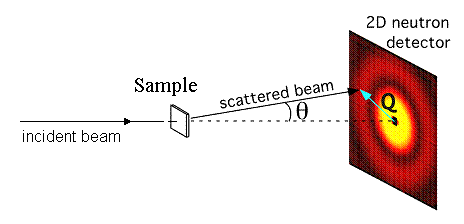Small Angle Neutron Scattering (SANS)

Small-Angle Neutron Scattering (SANS) probes material structure on the nanometer (10-9 m) to micrometer (10-6 m) scale. Structures on this length scale are critical to the performance of advanced engineering materials. For example, the toughness of high impact plastics depends on the admixture of stiff and flexible segments of polymer molecules on the nano-to-micro scale. Nanometer/micrometer structure is also crucial to biological processes in cells, to the storage of information on magnetic disks, to the hardness of steels and superalloys, to the conduction of current in superconductors, and many other materials properties.
Through the use of cold (i.e. long wavelength) neutrons and tight beam collimation, the SANS instruments at the NCNR are able to probe structure on a length scale (d) ranging from 1 nm to nearly 10,000 nm. The neutron wavelength (λ ) and scattering angle (θ) determine the length scale probed through the relationship
$$d \approx \frac{\lambda}{\theta} \frac{(wavelength)}{(scattering angle)}$$
Low-Q Seminar Series: An informal seminar series called the Low-Q Seminar Series is underway to discuss current research and development. These informal talks are given typically every two weeks.
SANS Book: Probing Nanoscale Structures - The SANS Toolbox (PDF), written by Boualem Hammouda, is a comprehensive guide to small angle neutron scattering with an emphasis on soft materials.
SANS Instruments
Data Reduction and Analysis
Reference Material
Contacts
SANS Information
-
(301) 975-2028

